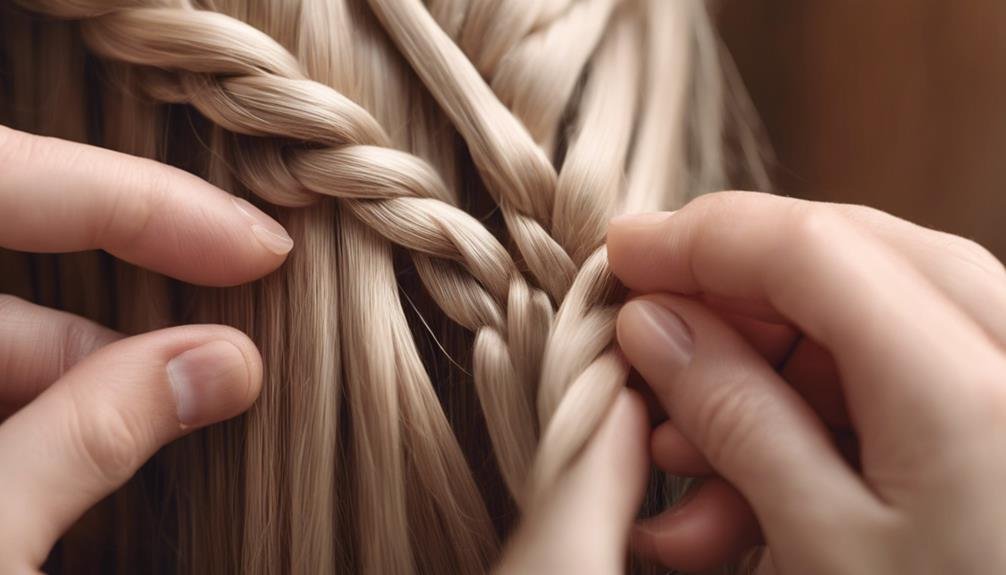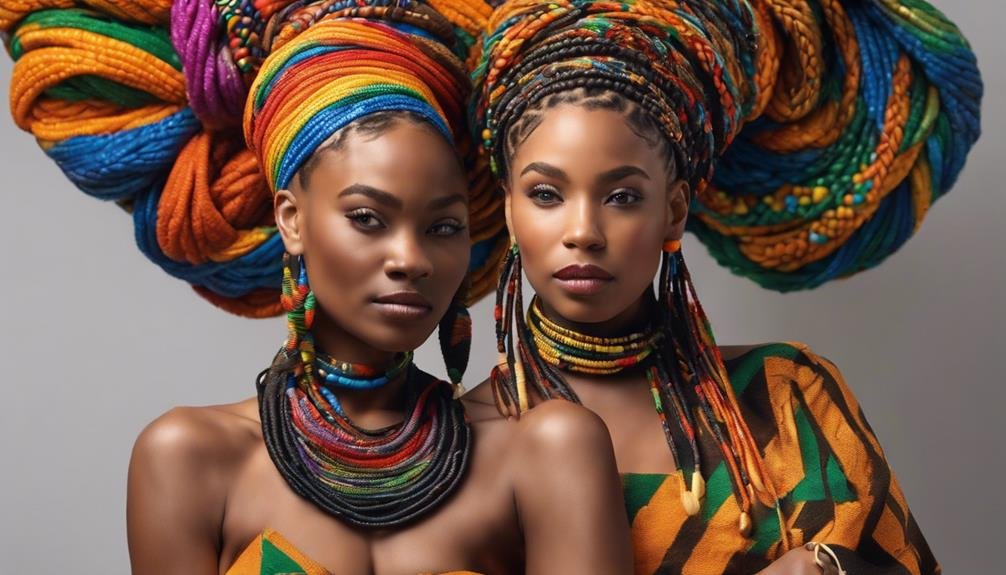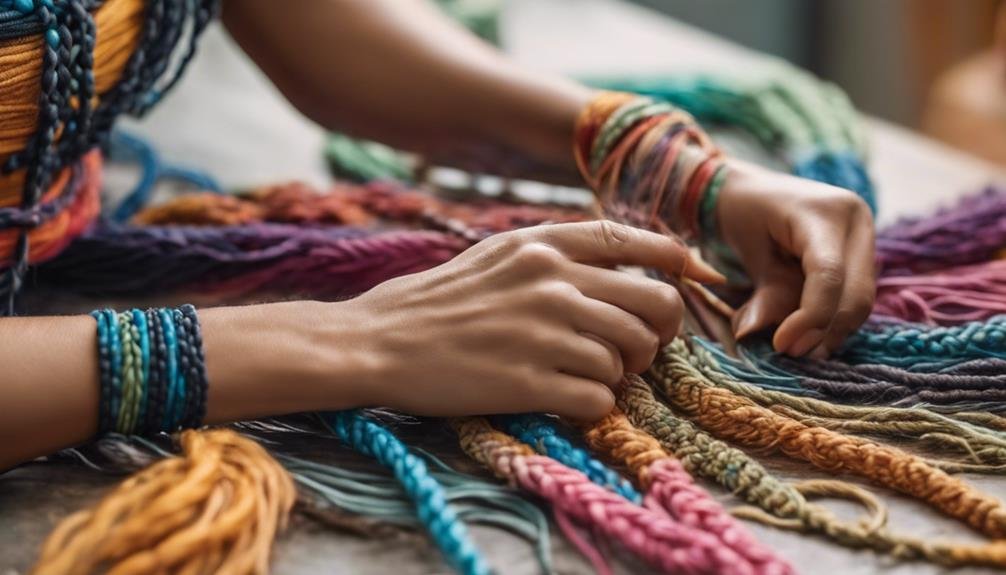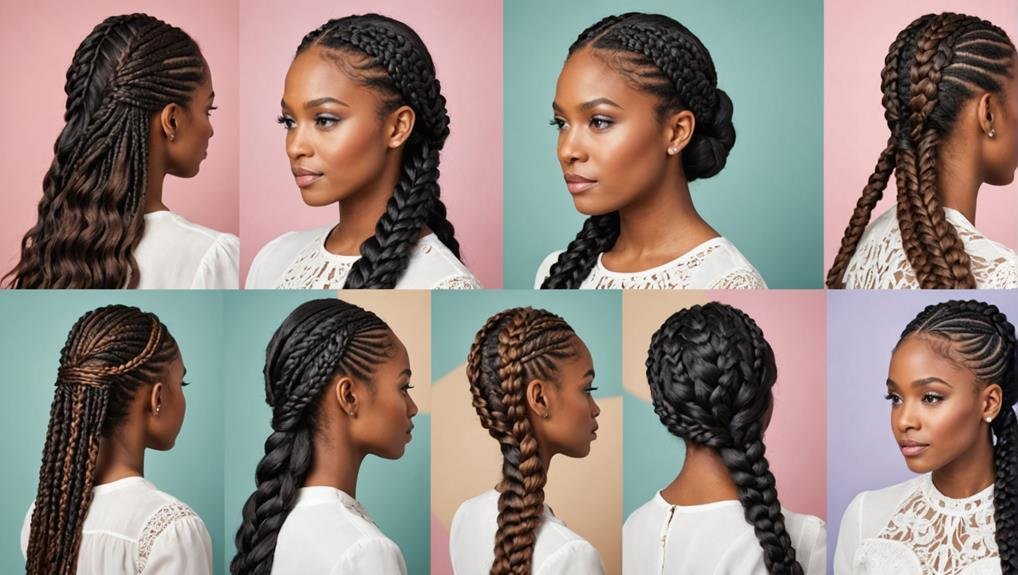When you think about braids, you might picture the classic three-strand version, but there’s a whole world beyond that. You’ve got French braids that weave in sophistication and Dutch braids that stand out with a bold, inverted look. If you’re feeling adventurous, intricate styles like the Viking Waterfall Braid or the regal Halo Braid offer something unique. Don’t forget African braiding styles such as Knotless and Ghana Braids, which celebrate and enhance natural textures. Are you curious about how to elevate your hairstyling game with these diverse options? There’s more to discover that might surprise you.
Key Takeaways
- Three-strand braids are foundational, crossing three hair sections look.
- French braids incorporate additional hair sections as you braid, creating a seamless pattern.
- Dutch braids feature side strands tucked underneath, resulting in a prominent, raised appearance.
- Fishtail braids mimic fish scales with two sections, offering a sophisticated, intricate design.
- Using a feed-in method, knotless braids provide a natural look with less tension.
Basic Braid Techniques

Braiding is an art form; mastering basic braid techniques is your first step into this enchanting world. Start with the classic three-strand braid, which lays the foundation for more complex styles. You’ll create a simple yet essential braid by dividing your hair into three sections and alternating the left and right strands over the middle.
Once you’ve mastered this, try a French braid. Begin at the crown of your head and add small sections of hair as you move down. This technique results in a secure and elegant style that is perfect for any occasion. It’s a versatile look that stands out.
Next, challenge yourself with a Dutch braid, a striking variation of the French braid. Instead of crossing the side strands over the middle, you’ll tuck them underneath, creating a braid that pops outward and catches the eye. It adds depth and dimension to your style.
These basic braid techniques set the stage for more intricate styles. With practice, braiding becomes a creative outlet, allowing you to express your personality through your hair. Enjoy the journey as you refine your braiding skills!
Intricate Braid Styles
You can explore more intricate braid styles that elevate your hair game after mastering the foundational braid techniques. Among these, the Viking Waterfall Braid stands out. It’s complex, starting with a waterfall technique that can evolve into Dutch, French, or three-strand braids. You’ll need a hairbrush and elastic to keep everything in place as you weave to a stunning finish.
The Halo Braid offers another intricate style. It involves. It involves wrapping a Dutch braid around your head for a crown-like effect. This style involves weaving the side sections under the middle, creating a seamless circle. Secure it with hair elastic ties and bobby pins for a polished look that turns heads.
French braids are a timeless, classic choice, perfect for keeping hair neatly out of your face. You add hair from the outside into each side strand, ensuring a snug, elegant braid.
Meanwhile, the fishtail braid is ideal for fancy occasions. Its intricate design weaves thin sections alternately to mimic a fish scale pattern. With a hairbrush and two hair elastics, you’ll craft a sophisticated, eye-catching look that is perfect for any event.
African Braiding Styles

As you explore African braiding styles, you’ll discover a rich tapestry of techniques that offer beauty and versatility. One of the standout styles is Knotless Braids, celebrated for their natural look and reduced tension on your hair and scalp. This style allows your hair to grow while giving you a chic and sophisticated appearance. Unlike traditional box braids, Knotless Braids begin with your natural hair, gradually adding extensions, which helps minimize stress on your roots.
Passion Twists are another trendy option among African braiding styles. They combine two-strand twists with loose ends, creating a curly, textured, playful, stylish effect. Passion Twists are perfect if you’re looking for something fresh and unique, as they balance a relaxed and polished look.
Beyond these, Triangle Box Braids present a bold alternative to classic box braids, featuring triangular sections that add an edgy twist to your style.
Meanwhile, Ghana Braids, or Banana Braids, use thick cornrows styled in intricate designs, adding length and volume.
For a more delicate look, consider Micro Braids, which are lightweight and versatile, allowing for numerous styling possibilities.
Braided Hairstyles to Try
Commence on a journey of creativity with braided hairstyles that are as diverse as they’re stunning. Start with the classic braid that never goes out of style. It’s perfect for casual days or when you need a quick, polished look.
For something more intricate, try French braids. Begin at the crown, adding small sections of hair as you go. This technique creates a beautiful, seamless pattern that adds elegance to any occasion.
If you’re looking for an outstanding style, opt for the Dutch braid. It’s similar to the French braid but has a bolder appearance, as the side strands cross underneath the middle. This gives the braid a raised effect, perfect for showcasing your braiding skills.
For special occasions, the waterfall braid offers a romantic touch. This style involves a horizontal French braid technique, allowing sections of hair to cascade down like a waterfall, creating a flowing, elegant look.
Braiding Tips and Tricks

Discover the secrets to perfecting your braiding techniques with these helpful tips and tricks.
When it comes to French braiding, textured hair, like wavy and curly types, offers more grip, making it easier to create intricate patterns. If you’re working with silky hair, don’t worry—volumizing powder can be your best friend. Just sprinkle a bit onto your hair to add texture and grip, making the braiding process much smoother.
Consider using a texture or micro-crimping iron for those with slippery hair. These tools can give your hair the added grip, preventing strands from slipping out of your braid.
When braiding older hair, it will be naturally less slippery, allowing for easier manipulation into detailed braid styles.
Braiding isn’t just about aesthetics; it’s a great choice for protective styles, especially natural hair types like 4A-C. These styles shield your hair from damage and promote healthy growth. Whether you’re going for a simple braid or a complex twist, these suggestions guarantee your braids stay intact and look stunning.
Conclusion
Immerse yourself in the world of braids and let your creativity shine. By mastering basic braid techniques, you can create everything from simple styles to intricate designs like the Viking Waterfall Braid or the regal Halo Braid. Delve into African braiding styles for a rich variety that celebrates natural hair. Remember, practice makes perfect, so don’t hesitate to experiment and refine your skills. You’ll elevate your hairstyling game with each braid and express your unique style.
FAQs
What are some popular types of braids?
Popular braids include the French braid, Dutch braid, fishtail braid, and box braid. Each braid style offers a unique look, from the elegant and classic French braid to the textured and trendy fishtail. Box braids are a protective style, while Dutch braids have a raised, 3D effect.
Key Points:
- French braid: Classic and elegant
- Dutch braid: Raised, 3D look
- Fishtail braid: Intricate, trendy pattern
- Box braids: Protective style for longer wear
How do I choose the best braid style for my hair?
Choosing the best braid style depends on your hair length, texture, and the occasion. French and fishtail braids are popular for their refined look for formal events. Dutch braids are ideal for a sporty or casual look, while box braids work well for protective styling, especially on natural or textured hair.
Key Points:
- Formal events: French or fishtail braids
- Casual/sporty: Dutch braid
- Protective style: Box braids for longer-lasting wear
What is the difference between a French and a Dutch braid?
The main difference between a French and a Dutch braid is the technique. In a French braid, sections are crossed over each other, creating a flat braid against the head. In a Dutch braid, sections are crossed under each other, resulting in a raised, 3D braid that stands out from the scalp.
Key Points:
- French braid: Sections crossed over for a flat braid
- Dutch braid: Sections crossed under for a raised effect
- Different techniques create distinct styles

